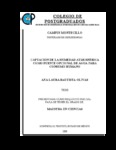| dc.contributor.advisor | Tovar Salinas, Jorge Leonardo | |
| dc.contributor.advisor | Palacios Vélez, Oscar Luis | |
| dc.contributor.advisor | Quevedo Nolasco, Abel | |
| dc.contributor.author | Bautista Olivas, Ana Laura | es |
| dc.date.accessioned | 2012-09-09T00:56:50Z | |
| dc.date.available | 2012-09-09T00:56:50Z | |
| dc.date.issued | 2008 | es |
| dc.identifier.uri | http://hdl.handle.net/10521/1509 | |
| dc.description | Tesis (Maestría en Ciencias, especialista en Hidrociencias).- Colegio de Postgraduados, 2008. | es |
| dc.description.abstract | Los objetivos de esta investigación fueron evaluar técnica y económicamente un prototipo
que obtiene agua de la humedad atmosférica en el Distrito Federal, y se comparó el costo
con abastecer agua con el Plan Acuario, el cual distribuye agua de manera gratuita en
camiones cisterna a sectores rurales de la población. La evaluación técnica consistió en
analizar el funcionamiento de los siete niveles del termostato del prototipo a una altitud de
2240 y 2241.2 m, con el Método de Tukey (!= 0.05), con base en la humedad relativa y
temperatura del ambiente registrado por 82 días, de los cuales se considero 28 días como
una muestra representativa de estas variables, además de medir la temperatura del
serpentín, el consumo de energía y el volumen de agua obtenido con el prototipo, con esta
información se calculo la eficiencia de cada nivel utilizado; y para evaluar la calidad del
agua obtenida del aire se tomaron tres muestras y se analizó el pH, SO4, Cl, y Na, los
resultados se compararon con la NOM-127-SSA-1994. La evaluación económica se
considero los costos y beneficios de obtener agua con el prototipo y se comparó con del
Plan acuario. Se concluyó que el nivel 7 de operación del prototipo fue el de mayor
contenido de agua y consumo de energía, el cual sublima el agua, el nivel uno de operación
condensa el agua, pero la cantidad de agua que obtiene es menor que con el nivel siete. La
calidad de agua que se obtuvo con el prototipo no es apta para consumo humano. El costo
aproximado de agua con el plan acuario es de $52.716 pesos el m3 y el costo de agua con el
prototipo es de $1800 pesos el m3, no es viable económicamente con la superficie de 1.7 m2
utilizados en el evaporador.________The objective of this investigation was to evaluate technically and economically a prototype
which obtains water from the atmospheric humidity in Mexico City, and comparing the
cost of supplying water with Plan Acuario which distributes water free of charge in tanker
trucks to rural sectors of the population. The technical evaluation consisted in analyzing the
performance of the seven levels of the thermostat of the prototype at an altitude of 2240 and
2241.2 meters, with the Tukey Method (!= 0.05), based on the relative humidity and
environmental temperature registered during 82 days; and considering 28 days as a
representative sample of these variables. Besides, the temperature of the coil, energy
consumption, and volume of water were measured in order to use this information for
calculating the efficiency of each level used; and to evaluate the quality of the water
obtained from the air, were taken three samples and the pH, SO4, Cl, and Na were analyzed,
and the results were compared with the NOM-127-SSA-1994. The economic evaluation
took into account the costs and profits of obtaining water with the prototype, and then was
compared with the Plan Acuario. The conclusion is that the operation level 7 of the
prototype was the level of higher water content and energy consumption, which sublimates
the water. Operation level 1 condenses the water, but the quantity of water is lower than
with operation level 7. The quality of the water obtained from the prototype is not apt for
human consume. The approximate cost of water with Plan Acuario is $52.716 m3 and the
cost of water with the prototype is $1800 m3, which is not economically viable with the
area of 1.7 m2 used in the evaporator. | es |
| dc.description.sponsorship | CONACYT | es |
| dc.language.iso | Spanish | es |
| dc.language.iso | spa | es |
| dc.subject | Condensación del vapor de agua | es |
| dc.subject | Punto de rocío | es |
| dc.subject | Evaluación técnica y económica | es |
| dc.subject | Calidad del agua | es |
| dc.subject.ddc | Maestría | |
| dc.subject.ddc | Hidrociencias | |
| dc.title | Captación de la humedad atmosfética como fuente opcional de agua para consumo humano | es |
| dc.type | Tesis | es |
| Tesis.subject.nal | Calidad del agua - México (Distrito Federal). | |
| Tesis.subject.nal | Condensación - México (Distrito Federal). | |
| Tesis.subject.nal | Agua de lluvia - México (Distrito Federal). | |
| Tesis.subject.nal | Captación de aguas - México (Distrito Federal). | |
| Tesis.subject.nal | Vapor de agua - México (Distrito Federal). | |
| Tesis.subject.nal | Rocío. | |
| Tesis.subject.nal | Humedad relativa. | |
| dc.subject.ingles | Condentation the steamer of water | es |
| dc.subject.ingles | Evaluation tecnically and economically | es |
| dc.subject.ingles | Water quality | es |

